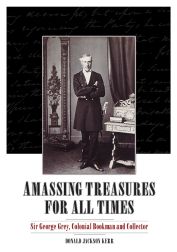Foreword
There are two cities in the southern hemisphere with public libraries housing what both know as 'the Grey Collection'. Both libraries are set beside splendid and semi-tropical Victorian municipal gardens, each with an almost identical statue of Sir George Grey, colonial governor and administrator, proudly surveying his dominions. The cities are Cape Town and Auckland. The two Grey Collections each include medieval illuminated manuscripts and rare printed books of unexpected range and quality, all gathered and presented to the public in what must at that time have been two of the most remote locations on earth. One bookseller, writing to Grey in 1881, asked for clarification of his client's unlikely address, 'for the devil himself could hardly make out the name of the place you wrote from' (it was Kawau Island, still probably the most inaccessible place medieval manuscripts have ever been kept).
The tale recounted here has many strands. It is an account, first of all, of an obsessive bibliophile, a passionate collector seeking and buying rarities from the bookshops and salerooms of nineteenth-century Europe, but competing against quite extraordinary odds when every order or exchange of letters took several perilous months by sailing-ship. To have assembled such a collection in a lifetime would be herculean. To have done so twice, as Grey did, giving his whole private library to Cape Town in 1861 and then beginning again for Auckland, is without parallel in book-collecting history. This, too, is a story of cultural turmoil and Victorian idealism. The Napoleonic and political upheavals of the nineteenth century had cast up many thousands of discarded medieval and early printed books onto the European market. As rapidly as collections from the ancien regime were scattered, other and very different libraries were formed from quite new perspectives. To watch Sir George Grey and his contemporaries sifting and selecting texts is to see in sharp focus a fascinating moment in the history of learning. All great collectors are driven by instinct; how they publicly justify their acquisitive urges is infinitely revealing of place and time. Grey gathered not only the classic monuments of European book culture, for the reassurance and edification of the new and rootless colonists, but also the artifacts and vanishing heritage of the indigenous peoples of the southern continents and islands themselves. We may dismiss nineteenthcentury education as severe and illiberal, but there is no doubting the public appetite for knowledge. C. W Holgate's An Account of the Chief Libraries of New Zealand (1886) records six hundred users a day in the Auckland city library, even before the arrival of the promised bequest from Grey: 'Those of my readers who have visited the Public Library at Capetown, and who have seen the Grey collection there, or know of it by reputation, will easily understand what Auckland has to look forward to', he wrote. Whether and how the books were appreciated in both cities, then and later, is itself a theme that would also make an intriguing study.
Finally, this is a story of a figure enormously famous in the early political history of southern Africa, Australia and, especially, New Zealand. Grey's public career is widely known, but to investigate a man's library we must follow him home and look along the shelves in his private study and peer into the boxes in his bedroom. There, at last, we can see what animated him late at night, with guests or (more usually) alone. Dr Kerr has actually lived and worked among Grey's library for many years. He has shared with Grey many of the private pleasures of pulling an original volume from the shelves, cradling it in one's hands, and of losing oneself utterly in the words or script or ornaments of five hundred or a thousand years ago. Book collectors understand each other across the ages. We all know in our own time, too, how much we can tell about a person now by looking at the books they possess. Francesco Petrarch, an author collected by Grey for both his libraries, referred to his books as his personal friends; meeting a man's friends brings you close to his heart. It is utterly captivating to watch Sir George Grey gathering and using his books, and to see what he read, or left unopened, and what he searched for in vain and how he kept and commended each volume as it arrived. An investigation of Grey's library reveals a very different and much more intimate picture of the grand colonial administrator and statesman. Grey's political innovations may have been largely superseded; his muddled marital life has been mercifully forgiven; but his books still survive, in South Africa and New Zealand, exactly as he intended. Probably, in the end, they will be his most enduring monument, and it is not a bad way to be remembered.
CHRISTOPHER DE HAMEL

